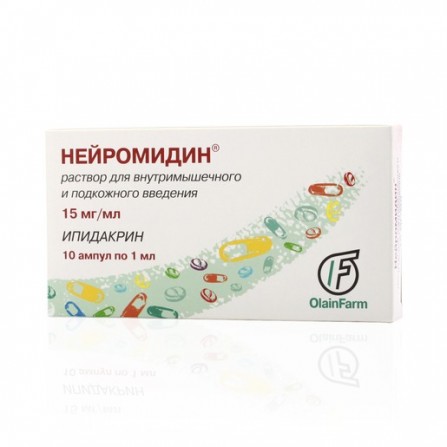Neuromidin solution for intramuscular and subcutaneous administration of 15 mg ml ampoule 1 ml 10 pcs
Condition: New product
996 Items
Rating:
Be the first to write a review!

More info
Active ingredients
Ipidacrine
Release form
Solution
Composition
Active ingredient: Ipidacrine. Concentration of active ingredient (mg): 15 mg
Pharmacological effect
Cholinesterase inhibitor. It has a direct stimulating effect on the conduction of the impulse along the nerve fibers, interneuronal and neuromuscular synapses of the peripheral and central nervous system. The pharmacological action of the drug Neuromidin is based on a combination of two mechanisms of action: blockade of the potassium channels of the neuronal membrane and muscle cells; reversible inhibition of cholinesterase in synapses. Neuromidin enhances the effect on smooth muscles not only of acetylcholine, but also of adrenaline, serotonin, histamine and oxytocin. Neuromidin has the following pharmacological effects: improves and stimulates the impulse in the nervous system and neuromuscular transmission; enhances the contractility of smooth muscle organs under the influence of agonists of acetylcholine, adrenaline, serotonin, histamine and oxytocin receptors, with the exception of potassium chloride; improves memory, inhibits the progressive development of dementia.
Pharmacokinetics
Absorption When s / c or v / m the drug is rapidly absorbed. Cmax in the blood plasma is reached in 25-30 minutes after administration. Distribution Binding to plasma proteins is 40-50%. Ipidacrine rapidly enters the tissue, the half-distribution period is 40 min. Metabolism Ipidacrine is metabolized in the liver. Excretion is excreted by the kidneys, as well as extrarenally (through the digestive tract). T1 / 2 of the drug when administered parenterally is 2-3 hours. Excretion by the kidneys occurs mainly by canalicular secretion and only 1/3 of the dose is excreted by glomerular filtration. When administered parenterally, 34.8% of the dose of the drug is excreted in the urine unchanged.
Indications
diseases of the peripheral nervous system (mono- and polyneuropathy, polyradiculopathy, myasthenia and myasthenic syndrome of various etiologies); diseases of the central nervous system (bulbar paralysis and paresis; recovery period of organic lesions of the central nervous system, accompanied by motor and / or cognitive impairment)
Contraindications
hypersensitivity to any of the components of the drug; epilepsy; extrapyramidal diseases with hyperkinesis; angina pectoris; pronouncedbradycardia; bronchial asthma; mechanical obstruction of the intestine or urinary tract; vestibular disorders; peptic ulcer of the stomach or duodenum in the acute stage; pregnancy (the drug increases the tone of the uterus); lactation period; children's age up to 18 years (there is no systematic data on the application). With caution: with gastric ulcer and duodenal ulcer, thyrotoxicosis, cardiovascular disease, as well as patients with obstructive diseases of the respiratory system in history or acute respiratory diseases.
Precautionary measures
The drug should be prescribed with caution in gastric and duodenal ulcers, thyrotoxicosis, diseases of the cardiovascular system, as well as in patients with obstructive diseases of the respiratory system in history or in acute diseases of the respiratory tract.
Use during pregnancy and lactation
The drug is contraindicated during pregnancy and lactation (breastfeeding). The drug does not have a teratogenic, embryotoxic action.
Dosage and administration
Peripheral nervous system diseases: - mono- and polyneuropathy of various origins - s / c or v / m 5–15 mg 1–2 times a day, a course - 10–15 days (in severe cases, up to 30 days); then the treatment is continued with a tablet form of the drug; - myasthenia gravis and myasthenic syndrome - n / a or intramuscular system 15–30 mg 1–3 times a day with a further transition to the tablet form. The general course of treatment is 1-2 months. If necessary, treatment can be repeated several times with a break between courses of 1-2 months. Diseases of the central nervous system: - bulbar paralysis and paresis - n / a or intramuscular 5–15 mg 1–2 times a day for 10–15 days; if possible, switch to tablet form; - rehabilitation with organic lesions of the central nervous system - in / m 10–15 mg 1–2 times a day, the course - up to 15 days, then, if possible, switch to a tablet form. If the next dose was not taken on time, then it is not taken additionally. The maximum daily dose is 200 mg.
Side effects
Caused by the excitation of m-cholinergic receptors: salivation, increased sweating, palpitations, nausea, diarrhea, jaundice, bradycardia, epigastric pain, increased secretion of bronchial secretions, bronchospasm, seizures. Salivation and bradycardia can be reduced by m-anticholinergics (atropine, etc.). Increasing the tone of the uterus, skin allergic reactions.Rarely (after applying higher doses) dizziness, headache, chest pain, vomiting, general weakness, drowsiness, skin reactions (itching, rash) were observed. In these cases, reduce the dose or briefly (1-2 days) interrupt the drug. These side effects are observed in less than 10% of patients.
Overdose
Symptoms: decreased appetite, bronchospasm, lacrimation, sweating, pupillary constriction, nystagmus, increased peristalsis gastrointestinal tract, spontaneous defecation and urination, vomiting, jaundice, bradycardia, impaired intracardiac conduction, arrhythmias, reduction in blood pressure, anxiety, worry, agitation, anxiety, ataxia, convulsions, coma, speech disorders, drowsiness, and general weakness. Treatment: the use of m-anticholinergics (atropine, cyclodol, metacin and others), symptomatic therapy.
Interaction with other drugs
Neuromidin increases the sedative effect in combination with CNS depressant drugs. The drug's effects and side effects are enhanced when used together with other cholinesterase inhibitors and m-cholinomimetic agents. In patients with myasthenia, the risk of a cholinergic crisis is increased while other people use Neuromidin with other cholinergic agents. the risk of developing bradycardia, if beta-blockers were used prior to treatment with Neuromidin. The drug can be used in combination nootropic preparatami.Alkogol increases the side effects of the drug.
special instructions
Use in pediatrics There are no systematic data on the use of parenteral form of ipidacrine in children. Impact on the ability to drive vehicles and control mechanisms During treatment, the patient must refrain from driving and occupations of potentially hazardous activities that require increased concentration of attention and quickness of psychomotor reactions.




